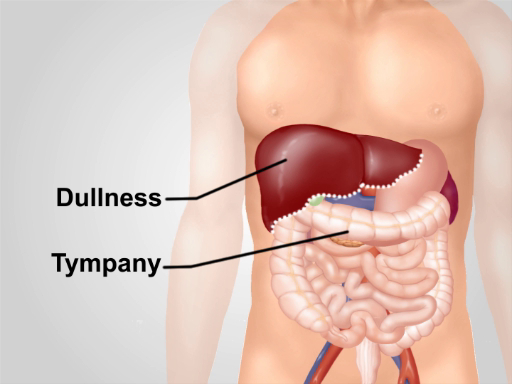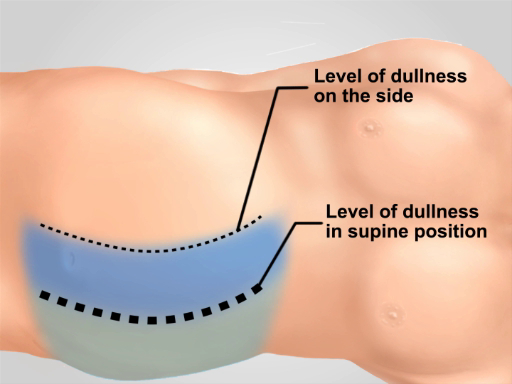腹部の試験 II: パーカッション
ソース: アレキサンダー Goldfarb、MD、助教医学部ベス イスラエス ディーコネス メディカル センター、マサチューセッツ州
医療のパーカッションは、体壁で軽くたたくことによって誘発される音の間のピッチの違いに基づいています。タップへの聴覚応答は容易体壁が振動して基になる臓器によって影響されます、ストロークと体壁の状態の強度に依存します。3 つの主要な医療のパーカッションがある: 共鳴 (肺で聞いた)、tympany (空気で満たされた腸のループで聞いて)、くすみ (流体または固体器官で聞いた)。Tympany または共鳴対くすみの間のコントラストとサイズ決定器官および固まりのマージンだけでなく流体蓄積の識別と統合の分野のことができます。パーカッションのまま物理的な診断の複雑な部分以来、200 年以上前、全国初、肺や腹部の検査で特に便利です。
パーカッションに従う目視検査と聴診、腹部の検査の一環として。審査官はべきである 9 つの腹部領域 (心窩部地域、右季肋領域、左季肋部、臍領域、右腰部、左腰部、下腹地域、右鼠径部および左鼠径部) のそれぞれの上最初打診。打楽器によって誘発される優しさが異常と腹膜の炎症が疑われるべきです。腹部の壁に最も近い空気で満たされた腸のループを配置すると腹腔内のほとんどの部分でパーカッションは主に鼓膜の音を引き出します。くすみの大きい区域の存在は、organomegaly、腹部の固まり、または流体の評価を促すべきです。
額と腹部ガスの分布を評価するとともに腹部の試験は打楽器による肝臓と脾臓のサイズの推定を含める必要があります。肝臓と脾臓は肋骨で覆われて、審査官は同様下の前胸部に打診する必要があります。通常、1 つは右前胸部、肝臓を介してのパーカッションの鈍い音と胃の空気の泡を左前胸部の打楽器と (図 1) 結腸脾彎曲部の鼓膜の音を聞くことを期待します。

図 1。腹部領域に通常打楽器のノート。右下の前胸部で肝臓にくすみの区を除いて tympany は地域の支配的な音。
1. 全般的なパーカッション、腹部の
- 患者への手順を説明します。
- 9 つの腹部領域のそれぞれの上軽いパーカッションを実行します。
- 打診すると、不快感の兆候の患者の顔を見る。任意の圧痛が発生しているかどうかは患者の要求します。パーカッションの優しさは異常な腹膜の炎症を示すことができます。
- 強度、ピッチ、および打楽器のノートの持続期間に耳を傾けます。通常、腸のループで空気により作られる鼓膜の音が聞こえます。鼓膜の音が比較的長い、甲高いと大声で。くすみ (低い投げられた、短くて静かな音 tympany より) の臨時エリア液や糞便、によって生成される、正常と同様です。くすみの大部分では、拡大臓器や触診と追加の操縦によって評価されるさらに、質量を示唆しています。
- 肋の余白上下の前胸部を打診します。通常脾臓と肝臓は肋骨縁下 1 ~ 2 cm が散見肝のエッジで、肋骨で覆われて。肝臓を介して右側の鈍い音になっています。左側、胃の空気の泡と大腸の脾彎曲部 tympany が聞こえます。
- 恥骨上打診します。この分野でパーカッション
スキップ先...
このコレクションのビデオ:

Now Playing
腹部の試験 II: パーカッション
Physical Examinations II
245.6K 閲覧数

目の試験
Physical Examinations II
75.9K 閲覧数

検眼鏡検査
Physical Examinations II
66.7K 閲覧数

耳の検査
Physical Examinations II
53.7K 閲覧数

鼻、副鼻腔、口腔、咽頭の検査
Physical Examinations II
64.6K 閲覧数

甲状腺検査
Physical Examinations II
103.5K 閲覧数

リンパ節試験
Physical Examinations II
381.3K 閲覧数

I: の腹部の試験検査・聴診
Physical Examinations II
200.7K 閲覧数

腹部の試験 III: 触診
Physical Examinations II
137.5K 閲覧数

IV の腹部の試験: 急性腹痛評価
Physical Examinations II
66.5K 閲覧数

男性の直腸の検査
Physical Examinations II
112.5K 閲覧数

包括的な乳房検査
Physical Examinations II
85.6K 閲覧数

性器の内診 i: 評価
Physical Examinations II
300.0K 閲覧数

内診 II: 鏡試験
Physical Examinations II
148.3K 閲覧数

内診 III: 両手と直腸試験
Physical Examinations II
145.5K 閲覧数
Copyright © 2023 MyJoVE Corporation. All rights reserved
